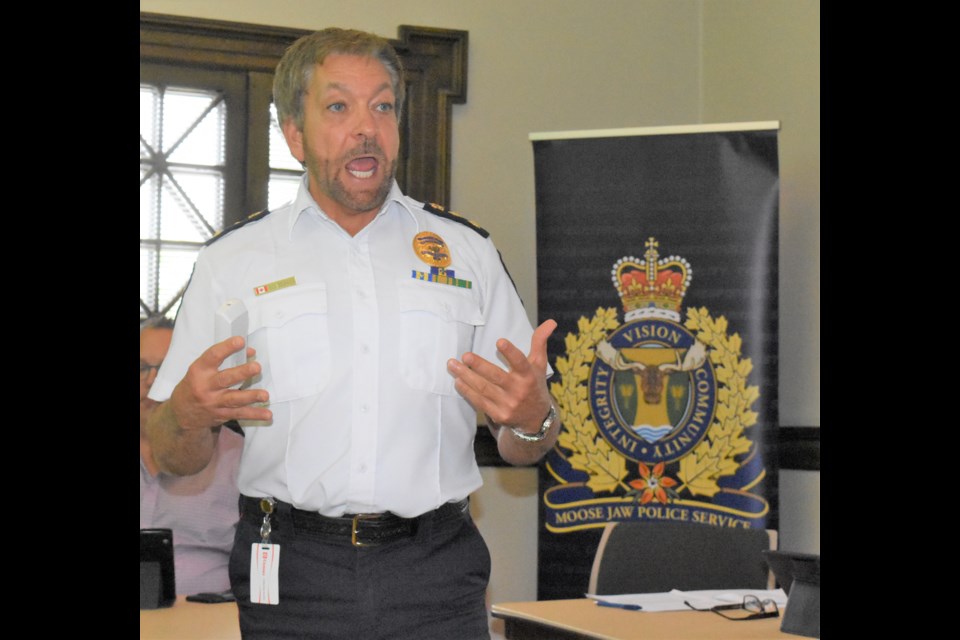The Moose Jaw Police Service (MJPS) has dealt with an increase in crime since 2014, so it has developed more tools to handle the problem.
The MJPS responded to 15,642 calls for service last year, which is a slight dip from 2014 when it responded to 16,432 calls. However, while the number of calls might have decreased slightly — more than 15,000 calls for service has been average over the last five years — the force is seeing more problems involving guns, drugs and violent incidents, explained Police Chief Rick Bourassa.
The number of incidents to which the police responded last year that were considered Criminal Code offences — from minor to major incidents — was 3,531, compared to 2,937 about five years ago.
“There has been an uptick in the calls to police,” Bourassa said on Sept. 10 during the Board of Police Commissioners’ meeting at the library. Calls to police were actually on the decline in the 1990s and early 2000s, but that has all changed in the last decade.
Moose Jaw’s crime severity index was measured at 121 last year which, in relation to other cities in Saskatchewan, puts the municipality in the middle of the pack, he continued.
The crime severity index (CSI) measures the volume of crime coming to the attention of the police. The rate counts all criminal incidents reported to and by police and divided by the population.
Meanwhile, the violent CSI indicates Moose Jaw’s rate increased to 100 incidents last year versus 45 in 2013, said Bourassa. Other major centres are seeing similar trends. The cause is partially due to cultural and societal shifts in the community.
“We are aware of that,” he continued. “We are not complacent. We are not sitting back.”
The MJPS is using several initiatives to combat crime in Moose Jaw, such as the South Central Child Abuse investigative team; the Police and Crisis Team (PACT); an expanded K-9 unit; tactical teams; and unmanned aerial vehicles (UAVs). Presentations about each were made during the meeting.
Other data presented show there have been 296 crimes committed against people so far this year, compared to 308 at the same time last year. Property crime incidents so far are 1,088 versus 1,202 last year, but break and enters are up 11 per cent.
There have been 10 charges laid so far for cocaine issues, compared to eight charges during the same time last year. Charges for meth have increased to 18 so far compared to 16 at the same last year.
Police are executing search warrants regularly on suspected drug dealers, while the force is in the early stages of developing a meth strategy. The goal, said Bourassa, is to decrease the supply of meth in the municipality and the region, while holding accountable the people who bring drugs here.
Restricting meth and other drugs from entering the community is important since they pose a danger, said Mayor Fraser Tolmie, chairman of the police commission board. People who use drugs can become violent. With the combination of drugs and firearms, this affects the safety of frontline police officers.
“There is a danger in (drugs). Stay away from the stuff. It will damage you,” he added.
Police understand there is crime occurring in Crescent Park and nearby areas, said Deputy Chief Rick Johns.
Police responded to 40 calls for service in the park last year, compared to 30 so far this year. There were four charges at the Natatorium this year compared to two last year, while there were two charges at the YMCA Fairford Street location this year compared to seven last year. Officers have been encouraged to engage in more foot patrols in the park.
There were 24 calls for service at the library last year, while there have been 17 this year, with eight charges laid. Police have also worked with the library to develop solutions to curb unwanted activities or loitering.


.png;w=120;h=80;mode=crop)

